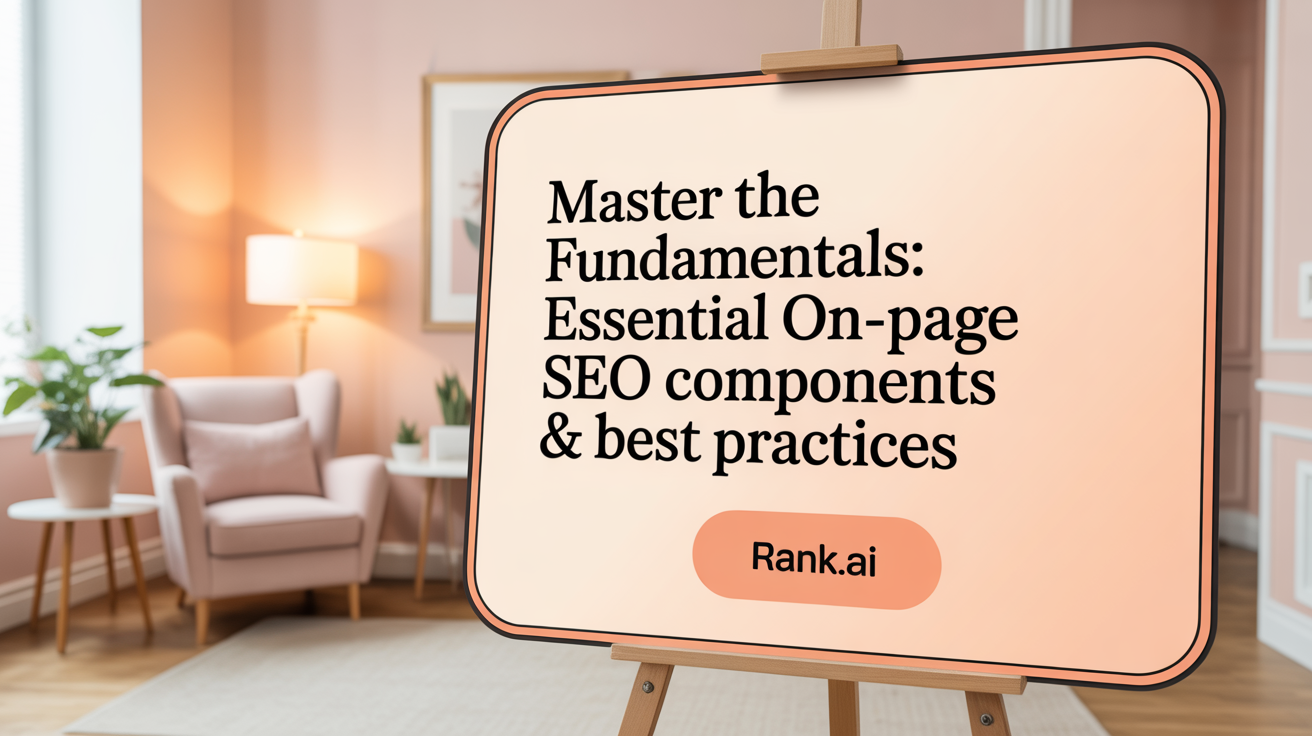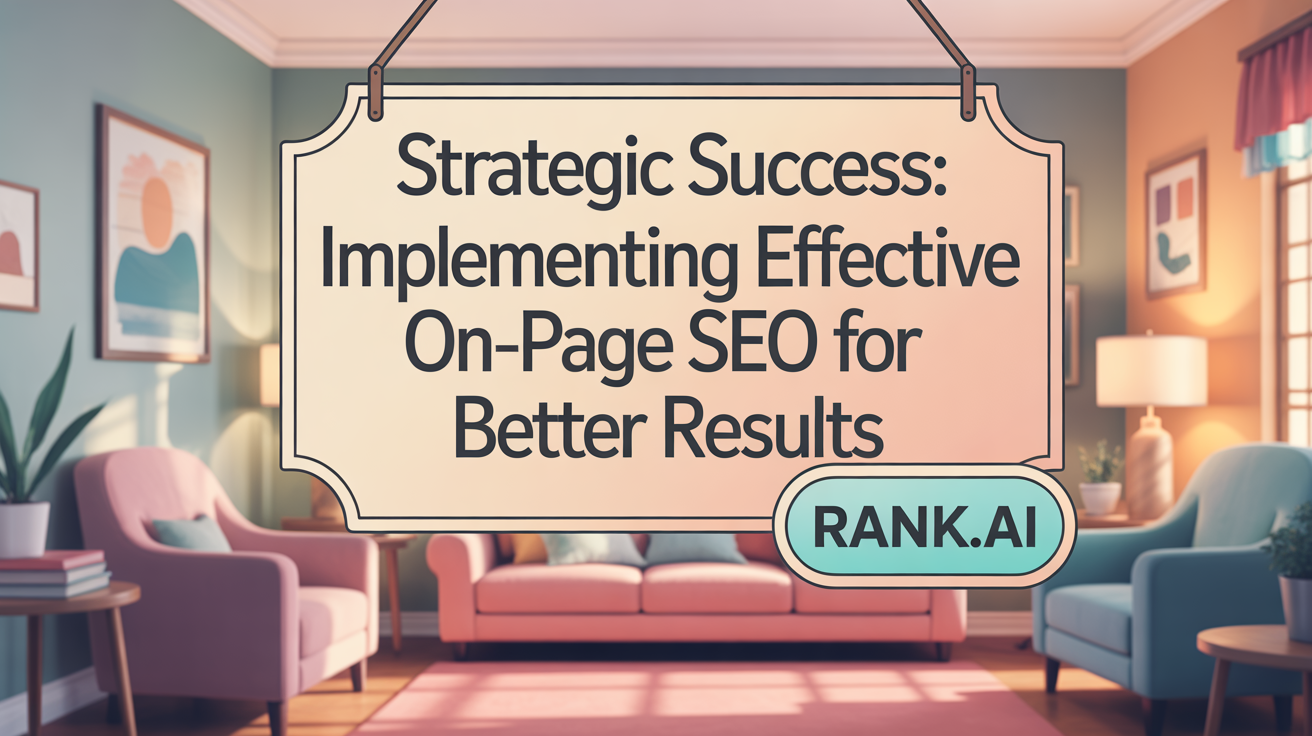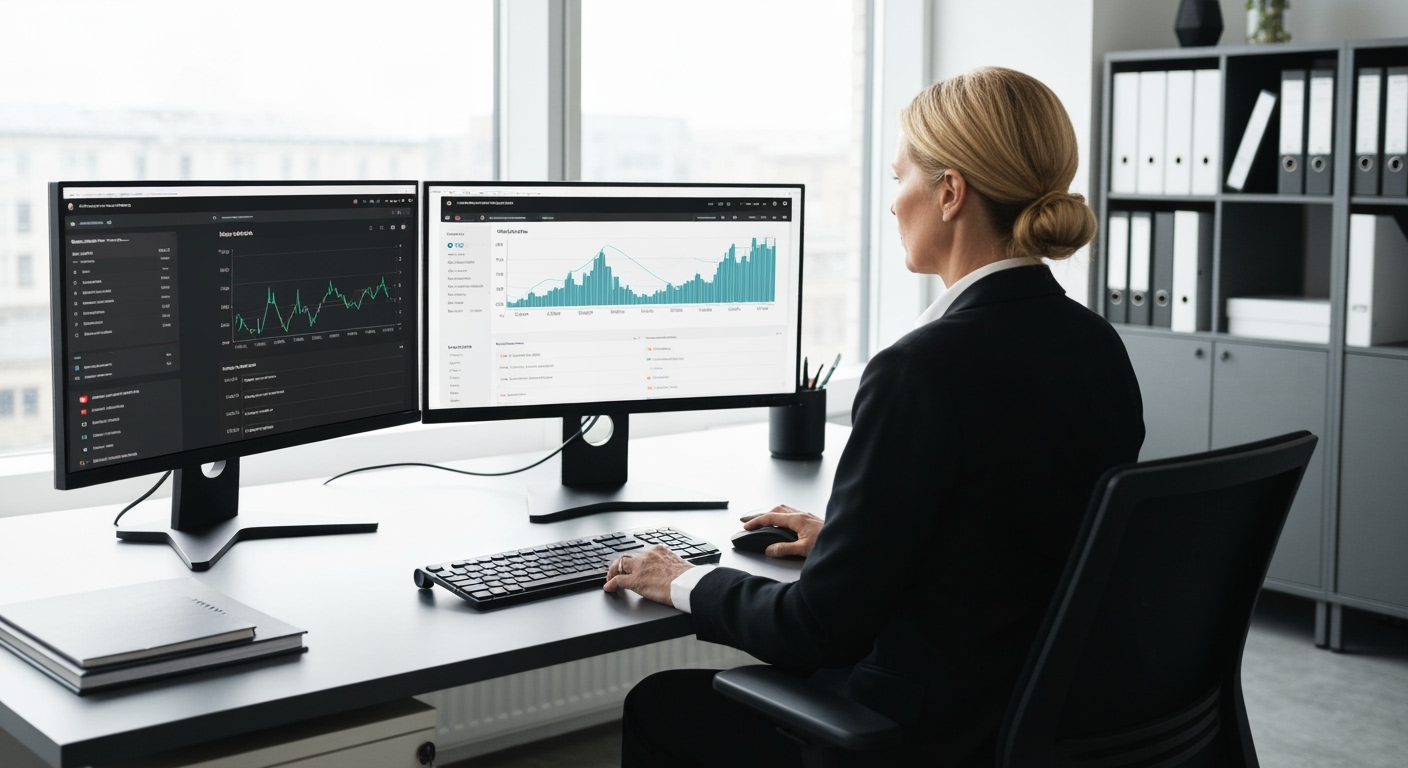Why On-Page SEO is Indispensable in Today's Digital Landscape
In an era where digital presence can make or break a business, on-page SEO stands out as a critical factor driving online visibility, user engagement, and competitive advantage. As search engines evolve, understanding and implementing effective on-page optimization strategies is essential for businesses vying for top rankings and meaningful traffic in an increasingly crowded market. This article delves into the importance of on-page SEO, the best practices to adopt, techniques to optimize webpage elements, and how these efforts fuel overall digital marketing success.
Defining On-Page SEO and Its Critical Role in Website Success

What is on-page SEO and why is it important?
On-page SEO involves adjusting various elements directly on a webpage to enhance its visibility and ranking on search engines like Google. This includes optimizing title tags, meta descriptions, headers, URLs, and images, as well as crafting high-quality, relevant content that aligns with what users are searching for.
In addition to content, on-page SEO addresses technical aspects such as increasing page speed, ensuring the site is mobile-friendly, and adding schema markup, which provides search engines with detailed information about the page.
The goal is to make the webpage both easier for search engines to understand and more appealing to visitors. When done effectively, on-page SEO boosts the webpage's relevance to search queries, increases organic traffic, and supports higher rankings. It’s a continual process that requires regular updates and adjustments to stay aligned with evolving search engine algorithms and user expectations.
Overall, on-page SEO is vital because it directly influences how well a webpage performs in search results, helps attract targeted visitors, and improves user experience, which ultimately drives website success.
Core Components and Best Practices of On-Page SEO

What are the key elements and best practices of on-page SEO?
On-page SEO encompasses several crucial elements that work together to improve a web page's visibility in search engine results. The foundation lies in creating high-quality, relevant content that naturally integrates targeted keywords. This content should be engaging and answer the searcher’s intent, boosting both relevance and user experience.
Meta tags are vital for on-page SEO. Optimized title tags should include primary keywords early and be compelling enough to attract clicks, while meta descriptions should be unique, descriptive, and also incorporate relevant keywords. These elements help search engines understand page content and influence click-through rates from search results.
URLs should be descriptive, concise, and keyword-rich to ensure both users and search engines easily comprehend the page hierarchy. Proper structuring with header tags (H1-H6) not only breaks the content into manageable sections but also emphasizes important topics for search engines.
Embedding internal and external links with relevant anchor text helps distribute page authority across your site and signals related content topics to search engines, enhancing overall relevance.
Visual content, especially images, must be optimized with descriptive alt text, appropriate sizing, and compression to improve loading speeds and accessibility.
Beyond content, technical considerations are pivotal. Maintaining fast page load speeds—ideally under two seconds—improves user experience and SEO rankings. A mobile-responsive design ensures the website provides a seamless experience across all devices, aligning with Google’s mobile-first indexing.
Implementing schema markup can enrich search snippets with additional information, making listings more attractive and informative. Regularly auditing your technical SEO aspects, such as crawl errors, broken links, and duplicate content, ensures your site remains optimized and discoverable.
Overall, effective on-page SEO integrates content quality, technical optimization, and a focus on user experience, all of which align with search engines' evolving algorithms and ranking criteria.
Best practices for optimizing content, meta tags, URLs, headers, images
To optimize content effectively, incorporate relevant keywords naturally within the first 100 words, headers, and throughout the body. Use header tags (H1 for the main title, H2 and H3 for subheadings) to structure content clearly, making it easier for users and search engines to understand.
URLs should be short, descriptive, and include primary keywords. For instance, www.example.com/seo-tips-2025 is preferable over www.example.com/page?id=123.
Images should have descriptive alt text that reflects their content and keywords where appropriate, which aids in image search visibility and accessibility.
Meta titles and descriptions should be crafted to accurately reflect the page content, include targeted keywords, and entice users to click.
Internal linking should use relevant anchor text to connect related pages, improving navigation and distributing page authority.
Technical SEO aspects like page speed can be boosted by compressing images, leveraging browser caching, and minimizing code. Mobile responsiveness involves adopting a flexible design that adapts to different screen sizes.
Incorporating schema markup allows rich snippets, such as reviews, FAQs, and product information, to appear in search results, increasing visibility.
Technical considerations such as page speed and mobile responsiveness
Page speed is critical for both user experience and SEO. Faster websites reduce bounce rates and improve rankings. Techniques to enhance speed include compressing images, optimizing code, and utilizing content delivery networks (CDNs).
Mobile responsiveness ensures your website functions well on smartphones and tablets. Given the increasing mobile traffic and Google’s mobile-first indexing, a responsive design is essential. This involves flexible grids, scalable images, and touch-friendly navigation.
Regular site audits using tools like Google's PageSpeed Insights can identify and resolve speed issues. Testing your site on different devices guarantees a uniform user experience.
In summary, combining technical optimization with high-quality content forms the backbone of effective on-page SEO strategies in 2025. Staying updated with emerging search features, such as structured data opportunities and voice search compatibility, further amplifies your website’s visibility.
Effective Techniques for Optimizing Webpage Elements

What on-page SEO techniques can be used to optimize webpage elements for better search performance?
Optimizing webpage elements is essential for improving search engine rankings and attracting organic traffic. A fundamental technique is conducting comprehensive keyword research to identify relevant terms with high search volume and low competition. These keywords should be naturally integrated into key areas such as the title tags, headers, and the initial 100 words of your content.
Meta descriptions play a critical role; they need to be compelling, unique, and include targeted keywords to entice users to click on your link in SERPs. Similarly, URLs should be concise, descriptive, and keyword-rich, reflecting the page hierarchy to improve relevance and ease of sharing.
Structuring content with header tags (H1, H2, H3) not only enhances readability for visitors but also helps search engines understand the content’s organization. Using descriptive, keyword-optimized headers signals the importance of various sections on the page.
Images should be optimized with descriptive alt text that includes relevant keywords, which boosts discoverability and accessibility. Compressing images ensures faster page load times, significantly improving user experience, which is also a ranking factor.
Internal linking to related pages distributes page authority across your site and makes navigation easier for visitors. External links to authoritative sources further boost credibility. Incorporating schema markup can enhance your search listings with rich snippets, increasing visibility.
Lastly, ensuring your website is mobile-responsive and loads quickly across devices is crucial, as Google’s algorithms prioritize mobile-first indexing and user experience metrics. Regularly auditing and updating on-page elements aligned with current best practices and user intent ensures sustained search performance.
By systematically applying these tactics, you can significantly enhance your webpage’s SEO and attract targeted, organic traffic.
Strategic Approaches to Implementing On-Page SEO Successfully
 Implementing on-page SEO effectively requires a combination of targeted keyword strategies, quality content creation, technical optimizations, and continuous performance monitoring.
Implementing on-page SEO effectively requires a combination of targeted keyword strategies, quality content creation, technical optimizations, and continuous performance monitoring.
One fundamental step is keyword targeting early in your webpage content and metadata. Conduct thorough keyword research to identify relevant search terms with high intent, and incorporate these keywords naturally into titles, headings, and meta descriptions. Ensuring that target keywords are front-loaded, especially in title tags and meta descriptions, can significantly boost click-through rates from search engine results.
Creating valuable, user-aligned content is equally crucial. Producing high-quality, unique, and useful content that fulfills the search intent of your audience helps position your page as an authoritative resource. Structuring content with clear headings (H1, H2, H3) not only enhances readability but also improves SEO relevance. Incorporating relevant keywords naturally within the content supports visibility while maintaining a positive user experience.
Optimizing images and URLs plays a vital role in on-page SEO. Compress images to improve page load speeds and add descriptive alt text to help search engines understand the visual content. Craft URLs that are concise, descriptive, and include relevant keywords to improve crawlability and usability.
Internal linking is another essential tactic. Create a logical site structure by linking to related pages with relevant anchor text, helping search engines discover and index all content efficiently. External outbound links to authoritative sources can also enhance your site’s credibility and relevancy.
Technical optimizations further enhance on-page SEO success. Implement schema markup to enable rich snippets, which can improve your listings’ visibility on SERPs. Ensure your website loads quickly—preferably within two seconds—and is mobile-responsive, aligning with Google’s mobile-first indexing policies.
Finally, consistent monitoring and updates are necessary to sustain SEO effectiveness. Use analytics tools to track performance metrics, identify areas for improvement, and adapt your strategies as search engine algorithms evolve.
By applying these comprehensive strategies, you can strengthen your on-page SEO efforts, leading to higher rankings, increased organic traffic, and better alignment with user expectations.
How On-Page SEO Drives Higher Search Engine Rankings

How does on-page SEO contribute to improving search engine rankings?
On-page SEO plays a crucial role in elevating a website's position in search engine results. It helps search engines understand the relevance, structure, and overall quality of a webpage. Key elements like optimized title tags, meta descriptions, headers, and URL structures signal to search engines the main topics and keywords targeted on each page.
Beyond metadata, proper content formatting—using clear headings, relevant keywords, and internal links—improves crawlability and helps search engines index content efficiently. Technical factors such as fast loading times, mobile responsiveness, schema markup, and secure protocols (HTTPS) enhance user experience and facilitate better crawling and ranking.
An important aspect is content alignment with user intent. By integrating targeted keywords naturally and providing valuable, high-quality content, on-page SEO indicates to search engines that the page is authoritative and directly relevant to the queries users are searching for. This relevance increases the likelihood of higher rankings.
The combined effect of these optimizations results in higher visibility in search results, more targeted organic traffic, and ultimately, better rankings. Continuous updates and adherence to SEO best practices ensure that a website remains competitive and can adapt to ever-changing search engine algorithms.
Benefits of On-Page SEO for Online Visibility and Traffic Growth
What benefits does on-page SEO offer for online visibility and traffic growth?
On-page SEO plays a crucial role in increasing a website’s visibility in search engine results and attracting targeted organic traffic. By optimizing essential elements such as title tags, meta descriptions, URLs, and content, it helps search engines better understand the relevance and authority of a webpage.
Effective on-page SEO ensures that content aligns with what users are searching for, fulfilling their intent and increasing the chances of ranking higher. Technical aspects like site speed, mobile-friendliness, and internal linking not only improve the website’s usability but also encourage visitors to stay longer, engage more, and convert.
Higher rankings often lead your pages to appear in featured snippets and rich results, which can significantly boost organic click-through rates. As a result, you receive more relevant traffic, which is more likely to convert into leads or sales.
Moreover, strong on-page SEO builds long-term authority and trust for your site. This sustained visibility grants a competitive edge, helping your website stay ahead in dynamic search landscapes. Overall, on-page SEO offers sustained growth benefits by making your website more attractive to both search engines and users, ensuring your online presence continues to thrive.
Integrating On-Page SEO Within Broader Digital Marketing Strategies
On-page SEO plays a vital role in the broader landscape of digital marketing, serving as a foundational element that supports and enhances other strategies such as technical SEO and off-page SEO.
It directly influences a website’s relevance and authority by optimizing key page components like content quality, meta tags, URLs, and internal links. These elements help search engines and users understand what each page is about, improving visibility and click-through rates.
Technical SEO ensures the website’s infrastructure supports effective crawling, fast load times, mobile-friendliness, and security, all of which complement on-page efforts by making sure that content is easily accessible and indexable.
Off-page SEO focuses on building domain authority through quality backlinks, social mentions, and online reputation, working synergistically with on-page efforts to boost overall search engine rankings.
Together, these strategies improve not only rankings but also how users interact with the website. When on-page SEO aligns with content marketing and paid campaigns, it fosters a consistent user experience, guiding visitors along the marketing funnel.
Effective on-page SEO enhances user engagement, increases conversions, and improves marketing ROI by ensuring the content is relevant, trustworthy, and accessible across devices. It helps attract targeted organic traffic, which often results in higher quality leads.
Furthermore, strong on-page optimization supports content strategies by making valuable information easy to find and share, while also complementing paid strategies like PPC ads by maximizing organic visibility.
Overall, on-page SEO acts as the backbone of digital marketing success. It ensures that all other efforts are anchored in content that resonates with the target audience and meets search engine requirements.
This integrated approach achieves a multiplicative effect: increased rankings, better user experience, and enhanced brand authority, all contributing to measurable improvements in traffic, engagement, and conversions.
On-Page SEO as a Competitive Advantage for Businesses
What is the competitive advantage that SEO provides to businesses?
SEO offers a powerful edge in today’s digital landscape by improving a company's visibility on search engines. When a website ranks higher in search results, it naturally attracts more organic traffic from interested potential customers. This increased exposure not only boosts brand awareness but also makes it easier for consumers to discover products or services conveniently.
Implementing effective on-page SEO strategies like keyword optimization, well-structured content, and internal linking can significantly enhance rankings. These tactics help search engines understand the relevance of a webpage to user queries, resulting in higher positions on results pages. As a result, businesses can lead the competition by appearing at the very top in relevant searches.
SEO also reduces dependence on paid advertising channels, making it a cost-efficient long-term marketing investment. While paid ads require ongoing budget allocation, organic rankings persist with proper optimization, providing continuous traffic and lead generation.
Understanding how search engine algorithms evolve and market trends shift allows businesses to stay ahead. By continuously refining their SEO strategies—such as updating content, optimizing for new features like featured snippets, and improving website technicalities—they can maintain or improve their positions. This proactive approach ensures they outperform competitors who neglect on-page SEO.
Overall, SEO helps establish a strong online authority, improving credibility and trustworthiness among users. By consistently optimizing web pages for relevance and usability, businesses can outperform rivals in the crowded digital environment, ensuring sustained growth and higher profitability.
Balancing On-Page and Off-Page SEO for Optimal Results
Understanding how on-page and off-page SEO work together is crucial for achieving top search engine rankings and driving organic traffic. On-page SEO involves optimizing the elements directly on your website, such as content quality, meta data, URL structure, internal links, and images. It lays the groundwork by helping search engines understand what your page is about and ensuring a good user experience.
Off-page SEO complements this by building your website’s authority outside of your site through backlinks, brand mentions, and social signals. These external factors boost your domain authority, which search engines see as a sign of trustworthiness and relevance.
Foundational on-page optimization is vital because it ensures your website is well-structured, fast-loading, mobile-friendly, and aligned with user search intent. These technical and content aspects make your site appealing both to visitors and search engines.
Meanwhile, off-page SEO amplifies this by increasing your site’s credibility. When reputable sites link to your content, it signals to Google that your site is authoritative, which can significantly improve your rankings.
Combining both strategies yields better results. A strong on-page foundation makes your site ready for high-quality backlinks, while off-page efforts support your SEO growth by elevating your domain authority.
| Strategy | Focus Area | Role in SEO | Additional Benefits |
|---|---|---|---|
| On-Page | Website content, meta tags, internal links, structure, images | Ensures search engines and users understand your site | Enhances user experience, speeds up indexing |
| Off-Page | Backlinks, brand mentions, social signals | Builds domain authority and trust | Increases credibility, broadens reach |
| Integration | Combining on-page and off-page activities | Maximizes visibility and rankings | Boosts traffic, improves long-term sustainability |
Is on-page SEO more important than off-page SEO? The answer is no. Both are equally vital parts of an effective SEO plan. On-page SEO provides the essential foundation for your website’s relevance and usability, while off-page SEO helps establish authority and reputation. Together, these strategies create a powerful synergy that can propel your site to the top of search results, leading to more visibility, higher traffic, and better engagement.
Ranking Factors: The Most Crucial On-Page SEO Elements to Prioritize
What are the most important on-page SEO factors to focus on?
To enhance search engine rankings and attract organic traffic, certain on-page SEO elements should be prioritized.
First, high-quality content that directly aligns with user intent is essential. This means providing valuable, relevant, and well-structured information that answers search queries comprehensively.
Next, optimizing page titles, meta descriptions, and header tags (like H1 and H2) helps search engines and users understand the main topics of each page. Effective titles should include target keywords early, while meta descriptions should be compelling and include relevant keywords to improve click-through rates.
URL structure also plays a vital role. Short, descriptive, and keyword-rich URLs improve usability and help search engines grasp the page’s purpose quickly.
Internal linking is another critical aspect. Strategic links between related pages distribute authority evenly across your site, improve navigation, and help search engines understand your website’s hierarchy and relevance.
Finally, proper use of meta tags and internal links enhances site crawlability and relevance signaling. All these factors work together to make your web pages more accessible, authoritative, and engaging for both users and search engines.
By focusing on these core elements, you can significantly improve your website’s visibility and ranking in search results.
Technical Foundations in On-Page SEO: Speed, Mobile, and Schema
How does page loading speed impact SEO and user experience?
Website speed is a critical factor for both search engine rankings and user satisfaction. Pages that load within two seconds tend to have higher engagement, lower bounce rates, and better conversion rates. Slow-loading pages frustrate users and increase the likelihood of abandonment. Search engines like Google prioritize fast websites because they provide a better experience; slow sites may be penalized or rank lower in search results.
Why is mobile-friendliness essential with the rise of mobile-first indexing?
With over half of all website traffic coming from mobile devices, Google has adopted mobile-first indexing. This means the mobile version of your site is considered the primary version for SEO purposes. Mobile-friendly sites ensure easy navigation, fast loading times, and accessible content across smartphones and tablets. Failing to optimize for mobile can significantly reduce your search visibility and user engagement.
How does schema markup enhance search result appearance?
Schema markup is a form of structured data that helps search engines understand your content better. By adding schema to your pages, you can enable rich snippets, such as star ratings, product prices, event details, or FAQ sections, to appear directly in search results. This not only improves your visibility but can also increase click-through rates, making your listing more attractive among competitors.
What about website architecture and crawlability?
A well-structured website with a clear hierarchy and accessible internal links facilitates effective crawling and indexing by search engines. Proper architecture ensures that important pages are easy to find and that link equity flows efficiently across your site. Using clean, descriptive URLs and a logical hierarchy helps search engines understand your content’s relevance and improves overall SEO performance.
| Aspect | Impact | Best Practices | Additional Details |
|---|---|---|---|
| Page Load Speed | Higher rankings, better user retention | Optimize images, leverage browser caching, reduce server response times | Fast sites improve engagement and reduce bounce rates |
| Mobile-Friendliness | Critical for rankings and user experience | Responsive design, avoid intrusive interstitials, readable font sizes | Mobile-first index prioritizes mobile versions for rankings |
| Schema Markup | Enhanced search listings | Use relevant schema types, validate markup, implement across important pages | Rich snippets attract attention and boost CTR |
| Website Architecture | Improved crawlability and ranking | Use logical hierarchy, internal links, create XML sitemaps | Ensures search engines can effectively index your site |
Staying updated on these technical aspects by researching "Technical on-page SEO best practices 2025" helps maintain competitive search performance and aligns with evolving ranking algorithms.
Optimizing Content Quality and Structure to Align with User Intent
Creating valuable, original, and relevant content
High-quality content is the cornerstone of on-page SEO. It should be unique, useful, and tailored to meet the needs of your target audience. Focus on providing answers that satisfy search intent, ensuring the information is detailed and trustworthy. Incorporate relevant keywords naturally within the content to enhance relevance without overstuffing, which can harm readability and rankings.
Using header tags for organization and SEO
Effective use of header tags (H1, H2, H3) structures your content clearly. These tags help both search engines and users understand the hierarchy and main topics of your pages. For example, H1 should contain the primary focus keyword and summarize the page's theme, while H2 and H3 tags organize subtopics and details, improving accessibility and SEO.
Incorporating keywords naturally and avoiding stuffing
Keyword integration should feel seamless and natural. Place target keywords at strategic points like the beginning of content, in headers, and within meta descriptions. Avoid overstuffing, which can reduce readability and lead to search engine penalties. Instead, focus on related terms and synonyms that support the main keywords, helping to match diverse search queries.
Regular content updates and adherence to E-E-A-T principles
Consistently updating website content keeps it relevant and authoritative. Follow Google's E-E-A-T guidelines—Expertise, Experience, Authority, and Trustworthiness—by including accurate, well-researched information, citing reputable sources, and demonstrating your expertise. Regular reviews and content refreshes improve search rankings and build audience trust.
Enhancing User Experience to Support On-Page SEO Success
How does design and UX impact search engine rankings?
Website design and user experience (UX) play a pivotal role in on-page SEO. A well-designed website that is intuitive and easy to navigate encourages visitors to stay longer and engage more with the content. Search engines interpret positive user interactions, such as longer dwell times and lower bounce rates, as signals of valuable content. Clear visual hierarchy, readable typography, and a clean layout help users find information quickly, leading to higher rankings.
Why are fast load times and mobile responsiveness important?
Page speed is a direct ranking factor; websites that load swiftly within two seconds improve user experience and positively influence SEO performance. Fast-loading sites reduce frustration and decrease bounce rates. Additionally, mobile responsiveness is essential because a majority of users browse on smartphones or tablets. Google’s mobile-first indexing means that the mobile version of your site is considered the primary version for ranking purposes. Ensuring your website adapts seamlessly to various devices helps maintain and boost rankings.
How does accessible navigation and clear site structure aid SEO?
A logical and accessible navigation structure enhances user experience and assists search engines in crawling your site efficiently. Clear menus, breadcrumb trails, and well-organized internal links make it easier for visitors to find related content and for search engines to understand page hierarchy. This improves indexation and boosts topical relevance, ultimately supporting higher search rankings.
What are the best practices for image optimization and compression?
Optimizing images involves compressing files to reduce load times without sacrificing quality. Tools like TinyPNG or ImageOptim can help achieve this. Descriptive alt tags improve accessibility for users with visual impairments and help search engines understand the content of images. Properly sized images that match display dimensions prevent unnecessary resizing during load, further enhancing site speed. Using next-gen formats like WebP can also reduce file size and improve page performance.
By focusing on these UX elements—design, speed, navigation, and images—websites not only provide a better experience for visitors but also improve their chances of ranking higher in search results. A user-centric approach is integral to effective on-page SEO, fostering trust and engagement that translate into sustained web presence.
Tools and Continuous Monitoring for Sustained On-Page SEO Performance
Maintaining a strong on-page SEO strategy requires ongoing analysis and adjustments. Several tools are available to help website owners and SEO professionals monitor and improve on-page factors. SEO auditing tools, like SEMrush’s Site Audit or Ahrefs Site Explorer, analyze a website’s health by identifying issues related to meta data, internal linking, content quality, and technical performance. These tools help uncover crawl problems, broken links, duplicate content, and other barriers to search engine visibility.
Keyword research and competitor analysis are foundational components of effective on-page SEO. Tools such as SEMrush Keyword Explorer and Moz Keyword Planner enable users to identify relevant keywords with high search volume and low difficulty. Additionally, competitor analysis tools show which keywords are driving traffic to similar sites, helping inform content strategies.
Regular technical SEO monitoring is essential for detecting crawl errors, page load issues, and schema markup problems. Google Search Console is a free tool invaluable for checking crawl errors, indexing status, and mobile usability. Combining these insights with crawl error detection software ensures that your website remains accessible and well-structured for search engines.
Given the constant evolution of search engine algorithms, it’s crucial to update content, meta tags, and website structure periodically. Staying informed about algorithm changes and adjusting strategies accordingly ensures sustained visibility. Continuous monitoring using comprehensive SEO tools enables site owners to adapt quickly, maintain performance, and safeguard their rankings.
For convenience, many use a combination of these tools in an integrated workflow to cover all aspects—from technical health to content relevance—to support ongoing SEO success.
Building a Future-Ready Website Through On-Page SEO Mastery
On-page SEO forms the backbone of a robust digital presence, directly influencing how search engines perceive and rank individual web pages. In a competitive market, mastering its elements—from content quality and keyword optimization to technical features like site speed and schema markup—is essential to outperform rivals and attract sustainable organic traffic. By integrating on-page SEO with broader marketing strategies, businesses gain a lasting competitive edge, ensuring higher visibility, better user engagement, and increased conversions. Continuous learning, regular audits, and technology adoption will enable companies to adapt to SEO’s dynamic landscape, securing their online success well into the future.
References
- Why On-Page SEO is Important (+ the Most Important Elements)
- On-Page SEO: What it is, Why it Matters, & How To Optimize
- On-Page SEO: The Definitive Guide + FREE Template (2025)
- The Benefits of On-Page and Off-Page SEO: Why You Need Both
- Why is on-page SEO important? | Authority Solutions®
- On-Page SEO: What It Is and How to Do It - Semrush
- All About On‑Page Search Engine Optimization - Mailchimp
- The Importance of SEO On-Page Optimization - V2Infotech
- Invest in On-Page Optimization Services to Beat the Competition
- Unlocking Success: Role of On-Page SEO for Online Stores - Inchoo



